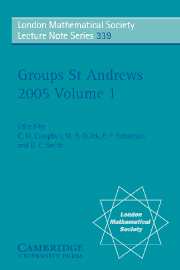Book contents
- Frontmatter
- Contents
- Introduction
- Aspects of infinite permutation groups
- Self-similarity and branching in group theory
- On surface groups: motivating examples in combinatorial group theory
- Nilpotent p-algebras and factorized p-groups
- Classification of finite groups by the number of element centralizers
- Algorithmic use of the Mal'cev correspondence
- Minimal but inefficient presentations for semi-direct products of finite cyclic monoids
- The modular isomorphism problem for finite p-groups with a cyclic subgroup of index p2
- On one-generated formations
- New results on products of finite groups
- Radical locally finite T-groups
- Explicit tilting complexes for the Broué conjecture on 3-blocks
- Conjugacy classes of p-regular elements in p-solvable groups
- An algorithm for the unit group of the Burnside ring of a finite group
- Integral group ring of the first Mathieu simple group
- Embedding properties in direct products
- Malcev presentations for subsemigroups of groups — a survey
- Finite groups with extremal conditions on sizes of conjugacy classes and on degrees of irreducible characters
- Conjugacy class structure in simple algebraic groups
- On automorphisms of products of groups
- Linear groups with infinite central dimension
- G-automata, counter languages and the Chomsky hierarchy
- An embedding theorem for groups universally equivalent to free nilpotent groups
- Irreducible word problems in groups
- Recent growth results
Malcev presentations for subsemigroups of groups — a survey
Published online by Cambridge University Press: 07 May 2010
- Frontmatter
- Contents
- Introduction
- Aspects of infinite permutation groups
- Self-similarity and branching in group theory
- On surface groups: motivating examples in combinatorial group theory
- Nilpotent p-algebras and factorized p-groups
- Classification of finite groups by the number of element centralizers
- Algorithmic use of the Mal'cev correspondence
- Minimal but inefficient presentations for semi-direct products of finite cyclic monoids
- The modular isomorphism problem for finite p-groups with a cyclic subgroup of index p2
- On one-generated formations
- New results on products of finite groups
- Radical locally finite T-groups
- Explicit tilting complexes for the Broué conjecture on 3-blocks
- Conjugacy classes of p-regular elements in p-solvable groups
- An algorithm for the unit group of the Burnside ring of a finite group
- Integral group ring of the first Mathieu simple group
- Embedding properties in direct products
- Malcev presentations for subsemigroups of groups — a survey
- Finite groups with extremal conditions on sizes of conjugacy classes and on degrees of irreducible characters
- Conjugacy class structure in simple algebraic groups
- On automorphisms of products of groups
- Linear groups with infinite central dimension
- G-automata, counter languages and the Chomsky hierarchy
- An embedding theorem for groups universally equivalent to free nilpotent groups
- Irreducible word problems in groups
- Recent growth results
Summary
Abstract
This paper introduces and surveys the theory of Malcev presentations. [Malcev presentations are a species of presentation that can be used to define any semigroup that can be embedded into a group.] In particular, various classes of groups and monoids all of whose finitely generated subsemigroups admit finite Malcev presentations are described; closure and containment results are stated; links with the theory of automatic semigroups are mentioned; and various questions asked. Many of the results stated herein are summarized in tabular form.
Introduction
A Malcev presentation is a presentation of a special type for a semigroup that embeds in a group. Informally, a Malcev presentation defines a semigroup by means of generators, defining relations, and the unwritten rule that the semigroup so defined must be embeddable in a group. This rule of group-embeddability is worth an infinite number of defining relations, in the sense that a semigroup may admit a finite Malcev presentation but no finite ‘ordinary’ presentation. Spehner [31] introduced Malcev presentations, though they are based on Malcev's necessary and sufficient condition for a semigroup to be embeddable into a group [22]. Spehner exhibited an example of a finitely generated submonoid of a free monoid that admitted a finite Malcev presentation but which was not finitely presented. He later showed that all finitely generated submonoids of free monoids have finite Malcev presentations [32]. Until the recent work of Cain, Robertson & Ruškuc [12, 11, 10, 9, 8], Spehner's two articles represented the whole of the literature on Malcev presentations.
- Type
- Chapter
- Information
- Groups St Andrews 2005 , pp. 256 - 268Publisher: Cambridge University PressPrint publication year: 2007
- 3
- Cited by

